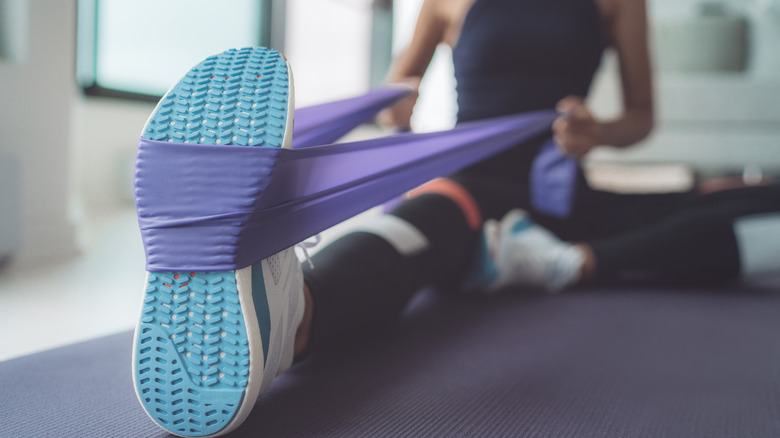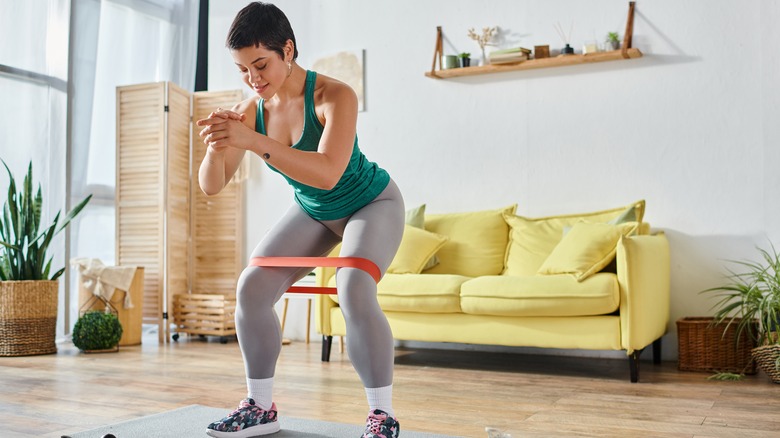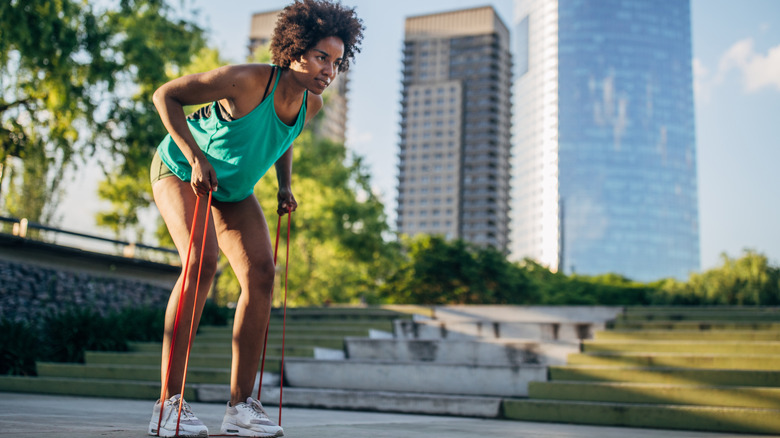Why Resistance Band Training Is The Workout You Need To Try
With the wealth of fitness knowledge available online these days, it can be tricky to identify which workouts are truly as effective as people say. Truth be told, a strong workout routine is highly subjective and not all exercises are a one-size-fits-all situation. However, when it comes to workout gear such as resistance bands, it's hard to go wrong. Resistance band training is a type of functional strength training commonly used for physical rehabilitation therapy, but many people now rely on resistance bands for at-home workouts, at the gym, and even during Pilates and yoga sessions.
To find out why resistance bands have become so popular in modern exercise circuits, Glam spoke to personal trainer and founder of DediKate Fitness Kate Georgiadis, MA, MS, CPT. "Many people started incorporating resistance bands into their workout routines during COVID because they are portable, don't take up much space, are cost-effective, and are relatively versatile," Georgiadis explains to Glam during an exclusive interview. "These are the main benefits I see with them: They're easy to carry around, store, and use in a variety of exercises, making them an excellent choice for home workouts or when you're on the go." Additionally, these multifunction bands not only help you recover from muscle injury, they also improve muscle tone, flexibility, core strengthening, and muscle imbalances. And the best thing about banded workouts is that they consist of exercises you can do every day — even at the office.
Are resistance bands as effective at building muscle as dumbbells?
When people think about building muscle, they're more likely to visualize weighted workouts involving dumbbells rather than stretchy bands, and yet both are capable of strengthening muscles. Is one better at building muscle than the other? "The answer depends on your goals, the specific exercises you're doing, and how you're using the equipment," Kate Georgiadis shares exclusively with Glam. "For example, resistance bands provide variable resistance, which means the tension increases as the band is stretched." In other words, the exercise feels harder once the band is fully stretched but doesn't offer as much resistance before the band fully stretches.
"This characteristic can be beneficial for targeting certain parts of the muscle during specific phases of an exercise," says Georgiadis, "but it also means that the resistance is not as consistent as with dumbbells, which rely on gravity to provide uniform tension throughout the movement." For this reason, dumbbells are more effective at building muscle mass due to the consistent resistance that they provide, which Georgiadis confirms is "key for muscle growth."
However, that isn't to say that resistance bands aren't useful during workouts. In fact, Georgiadis reveals that banded exercises are great for improving muscle strength in older adults with health conditions such as sarcopenia or type 2 diabetes. A 2023 study published in Scientific Reports also found that strength training with resistance bands may lead to more supple skin by increasing the thickness of the dermal layer of your skin.
The best at-home resistance-band workouts
Resistance band kits are all similar, for the most part, but fitness trainer Kate Georgiadis recommends the brand Rogue. "They're durable, reliable, and come in a range of resistance levels," she tells Glam exclusively. She also shares a full resistance band routine that consists of three sets per exercise for both upper and lower body workouts. First, she suggests warming up before your workout by doing two sets of 15 to 20 reps of band pull-aparts. "Stand with feet shoulder-width apart, hold the band with both hands, and pull it apart at chest level," she explains.
For the upper body, she recommends 10 to 12 reps of lateral raises and 12 to 15 reps of bent-over rows, bicep curls, and chest presses. "Stand on the band with feet hip-width apart, hinge at the hips, and pull the band toward your torso, focusing on squeezing your shoulder blades together," Georgiadis says, explaining how to do a bent-over row. Next, she prescribes a lower body routine with 10 to 12 deadlifts, 12 to 15 banded squats, 15 to 20 glute bridges, and 15 standing leg abductions. To cool down, Georgiadis says to "lie on your back, loop the band around your foot, and gently pull your leg towards you to stretch your hamstrings," holding the stretch for 30 to 60 seconds per leg. "By carefully selecting and setting up your exercises," says Georgiadis, "you can use resistance bands to complement your workout routine, regardless of whether your primary focus is building muscle, improving endurance, or simply adding some variety to your training." Hot tip: Use banded exercises in addition to free weights for killer gains.


